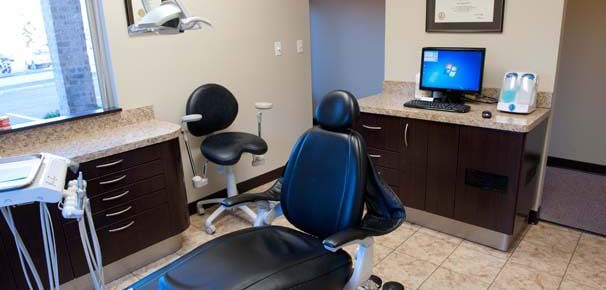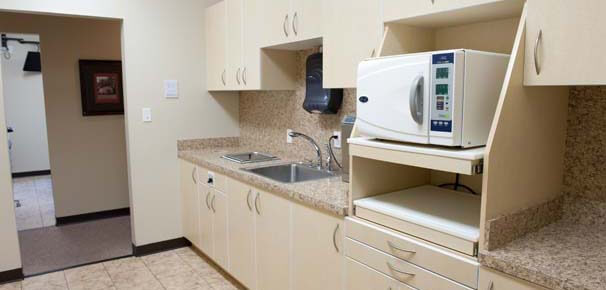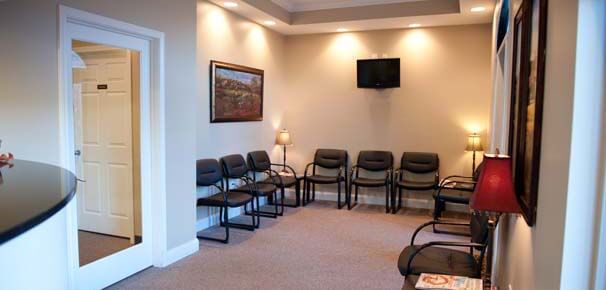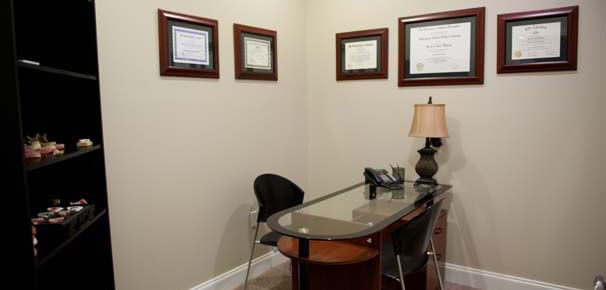Our Office
Procedures
- Exams – Routine exams are the best way to increase the odds that your dental treatment doesn’t become complex and expensive. Many people are afraid to come to the dentist and wait until a “problem” arises before scheduling an appointment. Often at that point the treatment needed will be more in depth and costly. Had routine visits been a part of their treatment, the now complex problem could have been diagnosed earlier and corrected with less invasive procedures. Another benefit of preventative exams is that they also include a yearly oral cancer screening. Most oral cancers have a good prognosis if caught early. Many times your dentist plays a key role in early detection.
- X-Rays – Routine exams are only part of the puzzle in diagnosing dental problems. Radiographs (x-rays) are critical in allowing the dentist to visualize decay, periodontal disease, or pathology that may not be visible with a clinical exam alone. Most x-rays should be taken once a year but some can be up to every five years.
- Cleanings – Having your teeth cleaned by a dental professional is also critical in maintaining optimal oral health. Even the best patients usually miss certain areas while brushing and flossing. Seeing your hygienist every six months can be the best preventative measure a patient can take.
- Sealants – Sealants are one of the least invasive treatments that give patients the most return. Sealants are usually performed on children soon after their permanent molars erupt. Sealants can also benefit adults who have deep grooves on the chewing surfaces of their teeth. It’s a process that uses a flowable resin material to “seal” the grooves and pits where cavities have a high potential of developing.
- Fluoride Treatment – Fluoride treatment is a quick non-invasive way to strengthen the enamel of a patient’s teeth. Most areas have fluoridated water, but in certain cases where a patient may be at high risk for cavities a supplemental treatment can be a big plus. Fluoride may also be used in certain cases to reduce tooth sensitivity.
- Composite Resin Fillings – Most commonly described as a “tooth colored” filling, resin fillings make up the majority of dental restorations placed. The composite materials used today provide an incredible match to the natural tooth without sacrificing strength. Resin fillings are technique sensitive and not suitable for every situation.
- Amalgam Fillings – Most commonly described as “silver fillings”, amalgam restorations have been the work horse of dental restorations for many years. Amalgam fillings are not as technique sensitive as resin fillings and are sometimes the material of choice. There has been some concern from patients in the past about the clinical safety of amalgam restorations. The American Dental Association states that amalgam fillings are safe and that studies have failed to find any link between silver containing mercury and any medical disorder.
- Crowns – A crown is a restoration that encases the tooth to provide strength and restore the tooth’s original shape and function. There are several reasons for placing a crown including cracked teeth, large restorations, defective restorations, root canal treated teeth, and cosmetic enhancement. A crown usually takes two appointments. The first appointment is to prepare the tooth and take an impression to have the final crown fabricated. The time it takes for a crown to be made is around two weeks. In the mean time a temporary crown is worn to prevent sensitivity or shifting of the teeth. There are several different types of materials used for crowns each with their own advantages and disadvantages. We will be glad to discuss your individual case and get the crown that best suits your needs and desires.
- Bridges – A dental bridge is a false tooth, known as a pontic, which is fused between two crowns to fill in the area left by a missing tooth. The two crowns holding it in place are attached onto your teeth on each side of the false tooth. This is known as a fixed bridge. This procedure is used to replace one or more missing teeth. Fixed bridges cannot be taken out of your mouth as you might do with removable partial dentures.
- Veneers are thin porcelain restorations that are bonded to the tooth. Veneers are used to reshape or change the color/shade of your smile. Veneers don’t require as much tooth preparation as crowns do and can be good alternatives to using full coverage crowns. Veneers are often used in cosmetic procedures where a patient wants to completely change their teeth to create a more attractive smile.
- Removable partial dentures (RPD’s) are used to replace a patient’s missing teeth. Unlike bridges or implants, rpd’s aren’t fixed in the mouth and can be inserted and removed by the patient. Rpd’s can be used to replace one missing tooth but are better suited for cases where there are multiple missing teeth. Rpd’s can be either metal based or acrylic. There are advantages and disadvantages to both. We will be glad to discuss your individual case and get the rpd that best suits your needs and desires.
- Complete dentures are for patients that don’t have any remaining teeth. Not every patient is a good candidate for conventional complete dentures. Complete dentures require a good foundation of bone and tissue to be successful. In cases where that foundation isn’t present, a denture supported by implants is a great option. This allows the patient to restore the esthetics and function of their teeth without the instability that can sometimes be seen with dentures. In certain cases surgery can be performed to increase the bony support needed by a denture to facilitate a more ideal outcome.
- Implants are designed to replace the root of a missing tooth. They are made of titanium and are placed in the jaw where there is a missing tooth. The coating on the titanium implant facilitates a biological integration of the implant and jawbone, thus allowing the implant to become part of the bone. Implants are placed with a minimally invasive surgical procedure. Depending on the site, an implant will integrate with the bone in 4-6 months. When esthetics are a concern some implants can be temporized immediately, while some need to wait until the integration process is complete. Implants can also be placed to aid in the retention of partial and complete dentures. There are cases when referral to a specialist may be best for the patient, such as multiple implants or insufficient bone for the implant.
- Nitrous Oxide – Nitrous oxide is an excellent adjunct to the dental office. It is an inhaled gas that induces a relaxed state making the dental experience more pleasant.
- Oral Conscious Sedation – In cases where a patient’s anxiety is high, the patient can opt to undergo oral conscious sedation. While this is not being “put to sleep”, it does induce a relaxed state via oral medication that is taken upon arrival at the office. Often times it allows more treatment to be done at one time thus decreasing the number of visits a patient needs to complete treatment. Not everyone will be suitable for oral sedation and certain criteria must be met before a patient is sedated.
- Root canal treatment is the process of removing infected or necrotic nerve tissue from the tooth and filling the empty chamber to prevent future infection. There are multiple reasons for a root canal including toothache, fractured tooth, abscessed tooth, or to facilitate restoration placement when there’s not enough tooth structure.
- There are times when despite the advances in dentistry, a tooth just needs to come out. Considering the options available to restore missing teeth, there may be a much better prognosis for treating the missing space than trying to restore the tooth itself. Each case is different and we’ll be glad to discuss your options. There are times when referral to a specialist may be best for the patient, such as severely impacted wisdom teeth or a patient requiring IV sedation.
- Everybody wants whiter teeth. We offer several options for whitening including in office laser whitening as well as at home whitening. Sometimes the whitening process can cause the patient’s teeth to be sensitive following the treatment. The sensitivity is usually short lived and things return to normal once the whitening process has been stopped. We can also offer several tips on how to decrease the post whitening sensitivity.
- Diagnosis – Gum disease is a very common problem in patients today. Gingivitis is an inflammation of the gums that can be a result of poor oral hygiene. When there is a long standing case of gingivitis it can result in loss of bone around the teeth. This is called periodontal disease. Periodontal disease is diagnosed radiographically and by a clinical exam. Along with decay it is one of the main reasons patients lose their teeth. Research has shown that periodontal disease can directly impact the overall systemic health of a patient.
- Treatment – Periodontal disease is treated by removing the factors causing the resorption of the bone. With the loss of bone around the tooth a pocket is formed between the tooth and the overlying gums. Once the pocket gets deep enough it is impossible to clean with conventional methods thus allowing tartar/calculus to collect in the pockets. This build up of tartar further exacerbates the periodontal disease process. Treatment is initiated by a hygienist removing the tartar from the pockets that have formed. This is often referred to as a “deep cleaning”. This is only the first part of the treatment. Having regular maintenance visits is just as important as removing the initiating factor.
- Maintenance – The effects of periodontal disease is not something we can necessarily reverse. There are surgical methods to help regenerate bone or decrease a pocket, but periodontal maintenance visits are essential in preventing further bone loss. Having the deep cleaning done without returning for maintenance visits will ensure the periodontal health will return to its previously diseased state. Depending on the situation three or four month recall visits may be scheduled to help maintain optimal periodontal health.
Welcome to Hagler Dentistry
Thank you for taking the time to visit our website. Feel free to contact us to schedule your appointment or ask any questions you may have. We’d love to talk to you about the treatment options we have available for you and your family. We are very excited about meeting the people of the community and building lifelong relationships with each patient
Our practice focuses on general dentistry which includes crowns, bridges, fillings, root canals, extractions, partial & complete dentures, cosmetic restorations, implants, whitening, routine cleanings and exams. Check out the list of our procedures to learn more about the treatment we can provide.
We have an excellent staff and we are certain they hold the same value in treating each patient with compassion and the utmost integrity.
We are proud to offer a wide range of services to our patients. We strive to provide state of the art comprehensive care in a comfortable pleasant atmosphere. In certain cases, referral to a specialist may be necessary. We have full confidence in the specialists we refer to and know you’ll be pleased with the treatment you receive. If you have any questions, concerns, or would like to schedule an appointment please feel free to contact us.
Most Major Insurances Accepted. Provider for BCBS, Southland, & MetLife. Ask about our financing program through Care Credit.









